
Zoop is a puzzle video game originally developed by Hookstone and published by Viacom New Media in 1995 for the Genesis, Super Nintendo Entertainment System, MS-DOS, Macintosh, PlayStation, Game Gear, and Game Boy, then in 1996 for the Saturn and Jaguar. Zoop has similarities to Taito's 1989 arcade video game Plotting, but Zoop runs in real-time instead. Players are tasked with eliminating pieces that spawn from one of the sides of the screen before they reach the center of the playfield. By pointing at a piece and shooting it, the player can either swap it with the current player color and thus arrange the same color pieces in a row or column, or match the color.

Earthworm Jim is a 1994 run and gun platform game developed by Shiny Entertainment, featuring an earthworm named Jim, who wears a robotic suit and battles the forces of evil. The game was released for the Sega Genesis and Super Nintendo Entertainment System, before being subsequently ported to a number of other video game consoles.
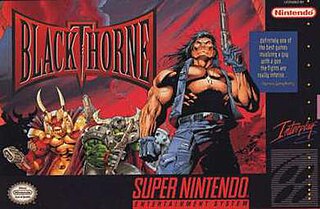
Blackthorne is a cinematic platform game developed by Blizzard Entertainment. It was released for the Super NES and MS-DOS in 1994. The cover art for the SNES version was drawn by Jim Lee. The following year, Blackthorne was released for the Sega 32X with additional content. In 2013, Blizzard released the game for free on their Battle.net PC client. In celebration of the company's 30th anniversary, Blackthorne was re-released for Nintendo Switch, PlayStation 4, Windows, and Xbox One as part of the Blizzard Arcade Collection in February 2021.
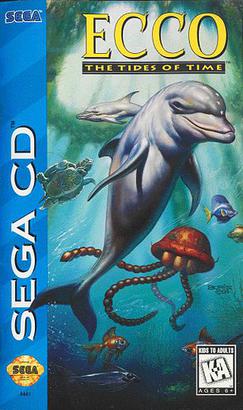
Ecco: The Tides of Time is an action-adventure video game developed by Novotrade International, published by Sega, and released for most of Sega's then-supported gaming consoles in 1994. It is the second game in the Ecco the Dolphin series. The Tides of Time continued the story of the first game and featured similar gameplay with a few new additions.

Earthworm Jim 2 is a 1995 run and gun platform video game and the sequel to Earthworm Jim, and the second and final game in the Earthworm Jim series developed by original creators Doug TenNapel, David Perry and Shiny Entertainment. It was released in late 1995 and early 1996 depending on region and video game console, initially being released for the Sega Genesis and Super Nintendo Entertainment System, before being ported to other platforms.

Primal Rage is a fighting game developed and released by Atari Games for arcades in 1994. The game takes place on a post-apocalyptic version of Earth called "Urth". Players control one of seven prehistoric beasts, that battle each other to determine the planet's fate. Matches feature many of the conventions of fighting games from the era, including special moves and gory finishing maneuvers. Ports were released for home video game consoles and personal computers. Efforts to perfectly emulate the arcade original have been unsuccessful due to the use of an unusual copy protection method. Toys, comics, a novel and other merchandise tie-ins were produced. More than 1.5 million copies of the game were sold.

Olympic Summer Games is an official video game of the Atlanta 1996 Olympic Games. It is the successor to Olympic Gold and Winter Olympics. It was the last "Olympic" video game released for the fourth generation of consoles, as well as the Game Boy.

FIFA 97 is a football simulation video game developed by EA Canada and published by Electronic Arts. It was released for PC on 24 June 1996 and versions for PlayStation, SNES, Mega Drive and Sega Saturn followed.

Pitfall: The Mayan Adventure is a side-scrolling action-platform video game developed by Activision in conjunction with Kroyer Films and originally published in North America and Europe in 1994. The fourth installment in the Pitfall! franchise, players assume the role of Pitfall Harry Junior as he embarks on a journey through the Mayan jungles of Central America in an attempt to rescue Pitfall Harry, his father and the protagonist of previous entries in the series, from the evil Mayan warrior spirit named Zakelua. Its gameplay mainly consists of action and platforming mixed with stage-based exploration using a main six-button configuration.
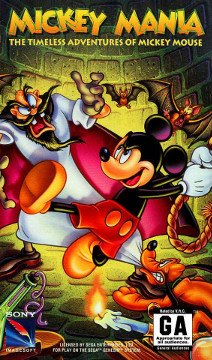
Mickey Mania: The Timeless Adventures of Mickey Mouse is a 1994 platform video game developed by Traveller's Tales and published by Sony Imagesoft for the Super NES, Sega Genesis, and Sega CD. In the game, the player controls Mickey Mouse, who must navigate through various side-scrolling levels, each designed and based on classical Mickey Mouse cartoons. The game was later released on the PlayStation in 1996 as Mickey's Wild Adventure in PAL regions by Sony Computer Entertainment, Sony Imagesoft's successor. A second game, Mickey Mania 2, was intended to be released but was cancelled due to Traveller's Tales focusing on other games.

Disney's The Jungle Book is a series of platform video games based on the 1967 Disney animated film of the same name. The game was released by Virgin Interactive Entertainment in 1994 for the Game Boy, Nintendo Entertainment System, Master System, Genesis/Mega Drive, Game Gear, Super Nintendo Entertainment System, and MS-DOS. While gameplay is the same on all versions, technological differences between the systems forced changes – in some case drastic – in level design, resulting in six fairly different versions of the 'same' game. This article is largely based upon the Genesis version.

The Lion King is a platform game based on Disney's 1994 animated film The Lion King. The game was developed by Westwood Studios and published by Virgin Interactive Entertainment for the Super NES and Genesis in 1994, and was ported to MS-DOS, Amiga, Game Gear, Master System, and Nintendo Entertainment System. The Amiga, Master System, and NES versions were only released in the PAL region. It is the final licensed NES game worldwide. The game follows Simba's journey from a young cub to the battle with his uncle Scar as an adult.
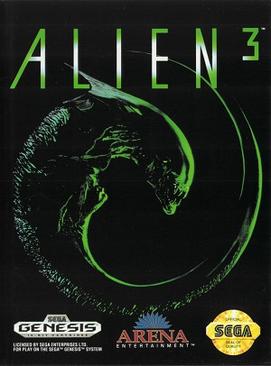
Alien 3 is a run and gun game based on the 1992 film of the same name. It was released for the Genesis and Amiga in 1992, then for the Commodore 64, Game Boy, Game Gear, Nintendo Entertainment System, Super Nintendo Entertainment System, and Master System.
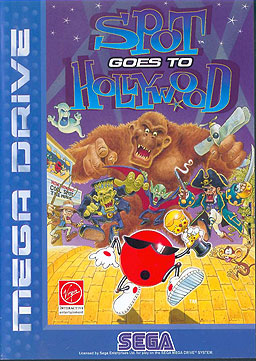
Spot Goes to Hollywood is a platform game developed by Eurocom and published by Acclaim Entertainment in North America and Virgin Interactive Entertainment in Europe for the Mega Drive/Genesis as the sequel to Cool Spot. Saturn and PlayStation versions were later released with full motion video clips and isometric graphics. The player controls Spot, once the mascot for the 7 Up soft drink, as it travels to various places trying to free its friends.
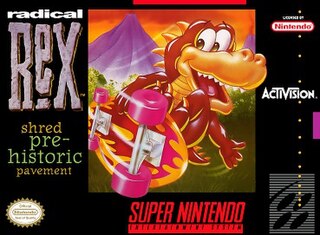
Radical Rex is an action platforming video game released in 1994 in North America, Europe and Australia. It is a remake of the 1993 Game Boy game Baby T-Rex. It was published by Activision and developed by Australian game studio Beam Software for the Super NES, Genesis, and Sega CD. A Microsoft Windows port of the Super NES version published by Piko Interactive was released on March 7, 2019. Piko also released the game as part of the Piko Interactive Collection 1 for the Evercade on June 8, 2020.

PGA Tour 96 is a sports video game developed by Hitmen Productions for the PlayStation, MS-DOS, and Windows versions, Unexpected Development for the Game Boy version, NuFX for the Sega Genesis and 3DO versions, Ceris Software for the Game Gear version, and Polygames for the SNES version and published by EA Sports for PlayStation, MS-DOS, Windows, Game Boy, Sega Genesis, 3DO, Game Gear and SNES.

NBA Live 96 is the second installment of the NBA Live video game series published by EA Sports and released on November 30, 1995. The PC and PlayStation covers feature Shaquille O'Neal of the Orlando Magic, while the Super Nintendo Entertainment System, Sega Genesis and European PlayStation box covers feature a photo of the tip-off to Game 1 of the 1995 NBA Finals. PlayStation and PC versions are the first games in the series to feature 3D-rendered courts, allowing for multiple camera angles using EA's "Virtual Stadium" technology, which is also used for FIFA Soccer 96. On-court player graphics remain 2D sprites. It is also the first NBA Live game released for the PlayStation and the only game for the Game Boy. NBA Live 96 is followed by NBA Live 97.

Toy Story is a side-scrolling platform game released by Disney Interactive in 1995 for the Sega Genesis, Super Nintendo Entertainment System, Game Boy, and Microsoft Windows. It is based on the film of the same name, and follows its plot. The game was followed by a sequel based on the second film, called Toy Story 2: Buzz Lightyear to the Rescue.
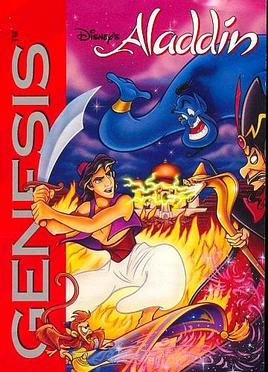
Disney's Aladdin is a platform game based on the 1992 film of the same name developed by Virgin Games USA. The game was released by Sega for the Sega Genesis on November 11, 1993 as one of several games based on the film, including another game that was released in the same month by Capcom for the Super NES.
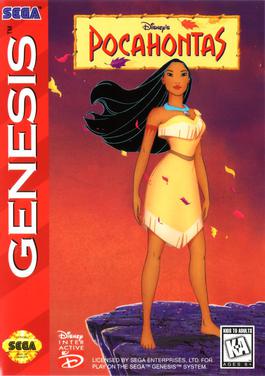
Disney's Pocahontas is a platform game based on the 1995 film of the same name. The Genesis / Mega Drive version was developed by Funcom on contract with Disney and was released on January 1, 1996. It was followed by a later version for the Game Boy developed by Tiertex Design Studios and released on June 10, 1996, nearly a year after the film's premiere. A Super Nintendo Entertainment System version of the game was under development, but was canceled due to development being too far behind to coincide with the Genesis release.


















